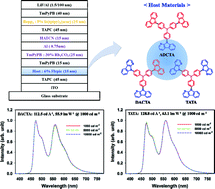Small single–triplet energy gap bipolar host materials for phosphorescent blue and white organic light emitting diodes
Abstract
We report extremely high efficiency tandem white organic light-emitting diodes (OLEDs) with newly synthesized host materials. Our new host materials have well balanced bipolar characteristics and very small singlet to triplet splitting energies (∼0.4 eV) due to almost no orbital overlapping between ground and excited states. The fabricated blue phosphorescent device with one of these host materials shows very high external quantum efficiency of 25.7%, low onset and driving voltages of 2.47 V and 3.49 V at 1 and 1000 cd m−2, respectively. High performance asymmetric tandem OLEDs could be fabricated by adopting these efficient and low driving voltage blue unit and very efficient yellow unit devices. Power efficiency of 63.1 lm W−1 and current efficiency of 128.8 cd A−1 at 1000 cd m−2 were achieved without any light out-coupling technology. We expect that blue phosphorescent OLEDs with our new narrow band-gap bipolar host materials could be a promising solution to make high efficiency white OLEDs for display and lighting applications.


 Please wait while we load your content...
Please wait while we load your content...